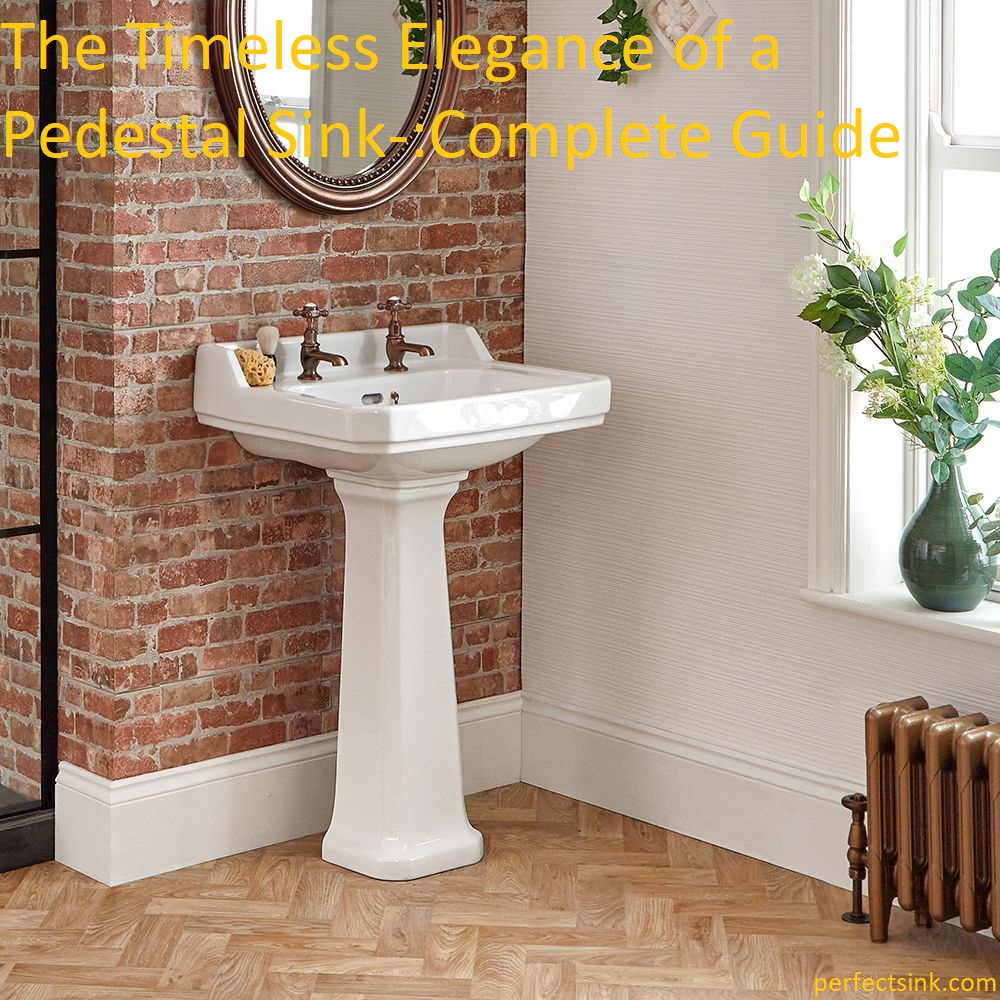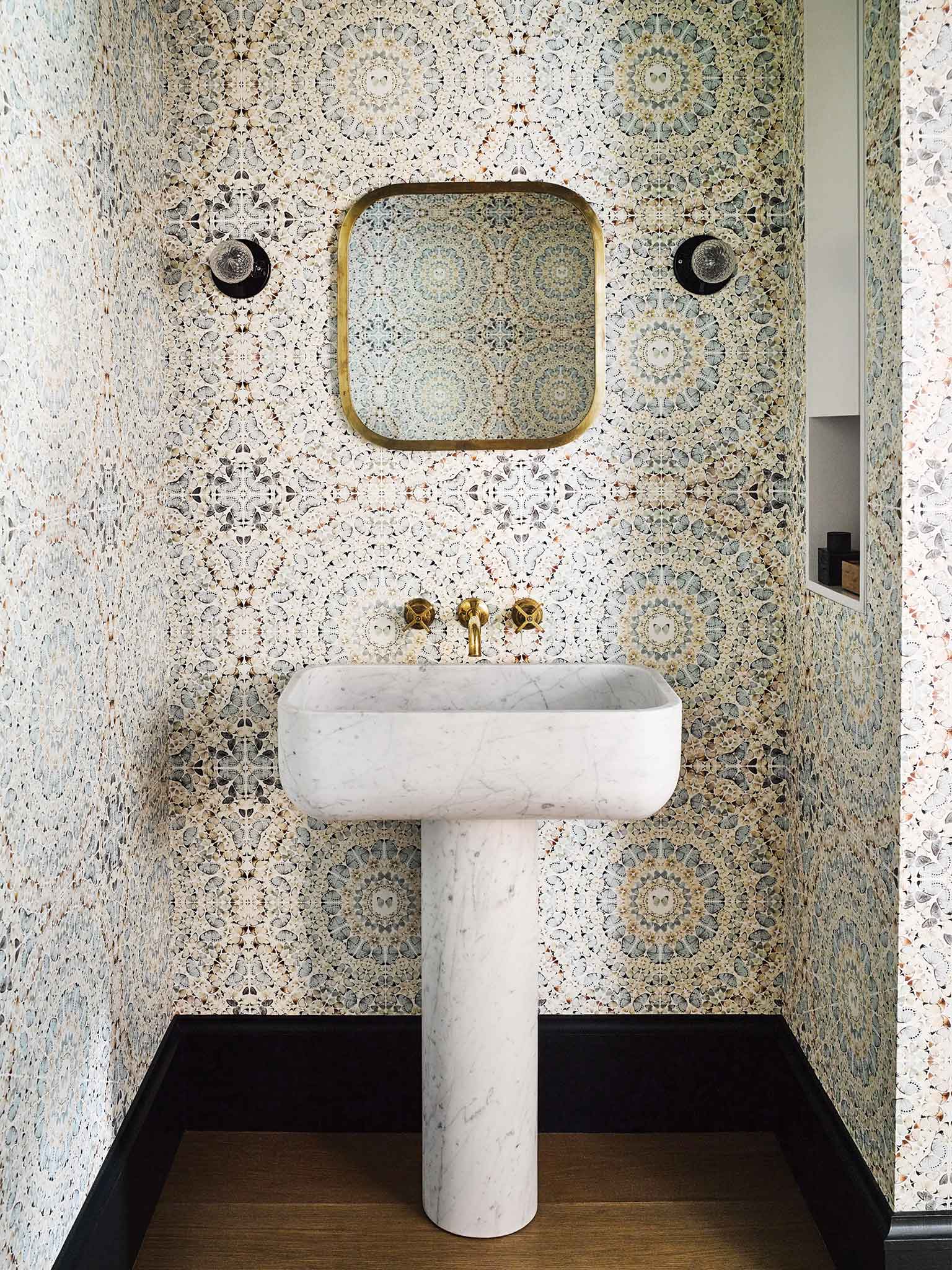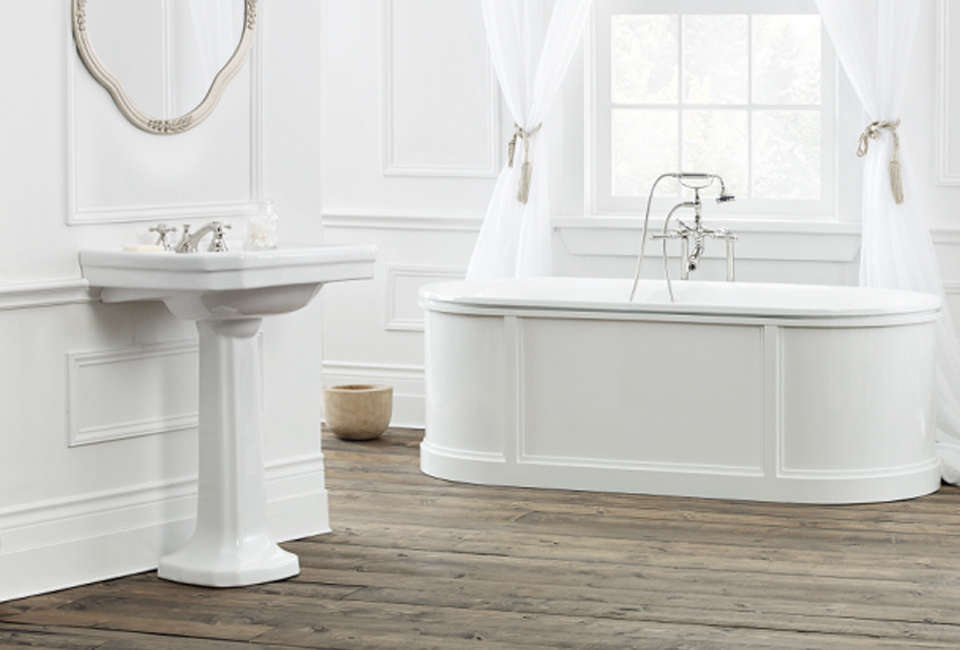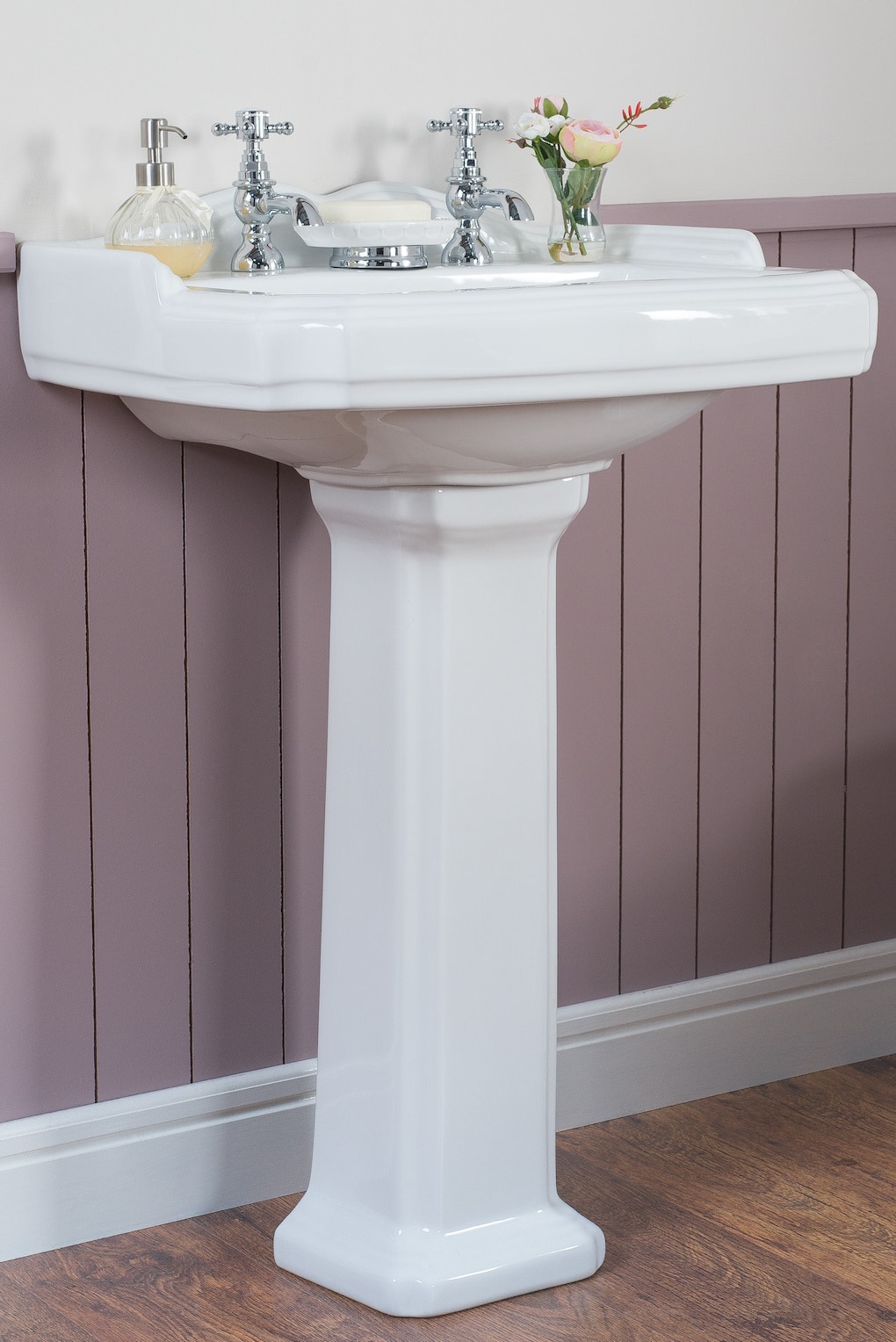Feeling overwhelmed by the endless options for your bathroom sink? Look no further than the timeless elegance of a pedestal sink.
This guide will show you how to choose, install and style this classic design, so you can feel confident in your choice. You’ll be amazed at the impact a simple, stylish pedestal sink can have on your bathroom.
Pedestal sinks are fixtures of timeless beauty and grace. Not only do they evoke a sense of classic old-world elegance, but they also offer a wealth of practical benefits. This guide will discuss these unique designs in detail, exploring the advantages and drawbacks as well as giving an overview of the installation process.
A pedestal sink is a freestanding washbasin that is set prominently in a bathroom without any lower support or additional storage units. These sinks can be made from ceramic, composite, brass, or stone materials and generally have a single hole for a faucet. They come in a variety of styles and shapes, from traditional to modern, allowing for plenty of flexibility when it comes to designing your dream bathroom.

Definition of a pedestal sink
A pedestal sink is a bathroom fixture that consists of a basin attached to a tall support structure that stands independently on the floor. This design, which was originated in the early 1900’s, has an elegant and timeless appeal that has remained popular for over a century.
The most common style features a column shaped base with one or two handles attached, although there are many other shapes and styles available. The traditional style has two flared feet and often includes decorative carvings around the edges or curves at the top of the post where it meets the basin. The basin itself is usually oval, round or angular in shape with a single center drain hole.
This type of sink provides ample storage beneath it due to its exposed backside, which allows additions such as shelves, drawers and cupboards to optimize space efficiency while keeping a classic aesthetic look. Pedestal sinks also come in various materials such as cast iron, fired clay, and even wood finishes allowing many options when planning your bathroom remodel.
Installation of a Pedestal Sink
After selecting the right pedestal sink for your bathroom and taking all measurements, it is time to install it. Depending on model and brand, you may need to do some assembly. Refer to the manufacturer’s instructions in this case. Once you have followed all the given instructions for assembly, here are some tips for safe installation:
-Choose a location which has sufficient support for the installation of the pedestal sink.
-Check for any water and waste pipes that may be present in that spot. If any exist, make sure you leave enough space so that new fittings can be attached easily.
-Use a screwdriver or drill to mount the fixing plates provided with the pedestal sink onto your wall in such a way that they are level. Make sure they are firmly secured into place by screwing them deeply into wall studs or an appropriate backing plate fixed inside a wall cavity.
-Secure screws firmly into wall plug inserts before attaching them until they won’t turn anymore (you may need to give them an extra half turn). If no plug inserts are present then secure screws using fish tape or wire strings as necessary (fixed at ceiling level).
-Fit brassware as per manufacturer’s instructions; tighten all parts securely by hand, not just with a wrench/spanner!
-Once everything is fitted correctly and tested, re-check all washers, nuts, plastic buffers and seals for suppleness and effectiveness – replace any suspect parts before closing up if found necessary!
Preparation

Before you install a pedestal sink, proper preparation steps should be taken. Depending on your situation, these steps will vary, but they should all ensure that the installation goes as smoothly as possible.
Pre- Installation Evaluation
Prior to beginning the actual task of installing your pedestal sink, you will need to evaluate the space you have and decide which type of sink is best suited for your needs. Is there enough room for a double basin? Are the walls strong enough to hold the weight of a single basin? Do you need shut off valves for hot and cold water supply lines? Consideration must also be given to plumbing fixtures and electrical wiring since these items could interfere with the installation process.
Ventilation/Drainage
If installing a new vent or drainage system is required, consult with a professional plumber first. Also make sure that any existing vents are unclogged and sufficient air flow circulates freely through all pipe connections. If an overflow drain is needed or if existing pipes do not measure up to code compliance, adjustments may be required before proceeding with the installation of your pedestal sink.
Outlets/Switches
If there are outlets or switches within 30 inches of where you plan on placing your pedestal sink, it’s important that they meet NEC electrical code codes regarding their location in relation to water sources. If this isn’t true in terms of either the existing outlet or switch locations, then relocating them may be necessary before proceeding with installation of your pedestal sink.
Tools and materials needed
Depending on the model of pedestal sink you are installing, there are certain tools and materials that you will need to make sure that your project is a success. Here is a list of basic items needed for most installations:
Tools:
- Electric drill with long reach bit attachment
- Hammer
- Screwdriver
- Level or plumb bob and string line
- Wood chisels
- Stud finder
- Plumber’s tape measurer
Materials:
- Wall mounting brackets or frame kit as required by manufacturer instructions. This may include screws, washers and wall anchors.
- Tapcon or other masonry anchors if attaching installation frame to concrete wall or floor
- Silicone caulk and sealant adhesive as recommended by the manufacturer instructions
- Drill bit that matches size of mounting screws
Step-by-step installation process

Installing a pedestal sink can be tricky and is best done with the help of a professional plumber or contractor. However, if you prefer to do it yourself, here is a step-by-step guide that will ensure you properly install your new sink.
- The first step in the process is to turn off the water supply leading to your old sink and drain the remaining water from the line. You may need to use an adjustable wrench to disconnect and remove your old sink if it’s attached to the wall or countertop. Next, remove all of your existing faucets and other parts that are connected to your existing sink.
- Measure the distance between existing water supply lines, then mark where you want them for your pedestal sink when installing it on its own set of pipes in order ensure everything fits correctly when you put it in place later on .
- Using special connectors, connect any pipes required for installing your pedestal sink as per manufacturer instructions. If you’re using copper pipes then use a welding torch and solder them together securely before putting them in place behind or beside the sink base. Secure pipe clamps at connections where necessary for extra security and stability.
- Place washer hoses behind the new pedestal base pipe connections so they’re protected by drywall once concealed by future tiling project or drywall covering Install shutoff valves if necessary (as per manufacturer instructions). Connect flexible hoses from shutoff valves directly into bottom of new faucets keeping excess hose trimmed up away from unit base but nearby [if needed] for optional reconnecting later on down road should unforeseen need arise again someday – emergency repair time saver).
- Remount pedestal base unit following original local building codes AND manufacturer instructions again.(should be provided in product literature accompanying product otherwise check manufacturer website). Use caulking around all sealing areas surrounding both base and side where wall meets after fully secured with proper mounting screws inside walls before continuing onto next stage (differs via type/model chosen).
- Attach Water supply lines securely onto each respective side/valve part using final tightening wrench tool included in kit Attach faucet securely using same last tightening wrench OR use appropriate size adjustment tool included with model bought.
- Test for leaks – ensuring proper connection is made -and turn on water at valve !
- Reconnect drainage fittings (as needed according to individual setup) carefully – caulk around drain assembly seal point as necessary
- Run one last test while observing leak check to make sure no leakage ensues–then rejoice!!
- Rough up surfaces of tile/drywall connection surrounding edges & secure edges of drywall sheet firmly
- Once dry completely, apply finishing touches according sheet rock connecting edge out
- Situate trimming options such as decorative edging-etc…in accordance with personal tastes
- Apply grouting perforating & wetting tiling surfaces as necessary within personal preference parameter measured & prefabricated
- Congratulations: You know have successfully completed installation processrequired To Configure That New -Beautiful Addition To Your Home Bathroom Decor!! !
Maintenance and Care of a Pedestal Sink
The pedestal sink has become increasingly popular for its timeless and elegant design. Whether you have just installed a new sink or inherited one from past homeowners, it is important to understand the maintenance and care needed to keep the visual appeal of your pedestal sink. Regular ownership of a pedestal sink requires minimal cleaning, but proper care will ensure a lasting product.
Pedestal sinks should be cleaned regularly, preferably once a week or before and after significant use. When cleaning your sink, pay particular attention to any visible buildup on the bowl or base. For stubborn areas, a soft bristle brush can be used with suitable cleaners such as mild dish soap and warm water. When cleaning is complete, use a microfiber cloth to dry each component of your pedastal sink.
In addition to regular cleaning, consider allowing your pedestal sink to air-dry before replacing any toiletries on top or sitting items beside it. This can help prevent watermarks from forming on the porcelain or steel interior sides of the bowl as well as keeping it looking pristine for longer periods of time.
To ensure that your pedestal sink remains visually appealing over time, proper maintenance must include protecting against scratches and protective sealants when necessary to shield against corrosion from tarnishing finishes. To protect against scratches caused by moving items across surfaces such as tray stands or brushes during cleaning process; use felt pads underneath items that may cause scratching on the surfaces of your old-world bathroom fixture designs. In order to achieve optimal color retention on stainless steel fixtures with tempered glass panels should receive sealant every few weeks in order to prevent discoloration and corrosion due to humidity in bathroom environments or harsh soaps used during cleaning processes.
Cleaning tips
Pedestal sinks are known for their timeless elegance, unique shapes and easy-to-clean surfaces. However, a number of cleaning tips will help keep the sink looking its best for years to come.
Common cleaning advice to maintain the beauty of your pedestal sink includes regular vacuuming and rinsing with plain water. Monthly deep cleanings with soapy water will also help maintain its shine while keeping it free from soap scum, hard water spots, toothpaste residue and more.
For really tough stains or mineral build up, vinegar can be used as an all-purpose cleaner as well as an effective stain remover. Finally, to protect and restore luster to your sink over time, consider applying a coat of wax or sealant on the surface on a regular basis.
Repair and maintenance

Regular maintenance will go a long way to preserving the beauty and functionality of your pedestal sink. In order to prevent major repairs, they should be regularly checked for leaks, cracks and other damage.
First, inspect the sink both inside and out for nicks or cracks that could cause water damage. Water spots can also reveal where a crack or hole is beginning to form, so it’s important to keep an eye on these areas as well.
If you find any problems, it’s usually best to address them right away to avoid further damage down the line. Cracks may be repaired by filling them with an epoxy-based filler material, while holes can be closed with a sealant. Be sure to use materials that are formulated for use in wet environments specifically – not general purpose home repair fillers – as these are more likely to last through repeated exposure to moisture.
Inspecting decorative fixtures regularly is also important in order ensure that the aesthetics of your pedestal sink stay consistent over time. Replace any missing grout between ceramic tiles and tighten all visible hardware such as screws and bolts before they loosen further into disrepair. Cleaning regularly will keep stains from setting in on surfaces; use gentler cleaners such as non-toxic dish detergents on faucets and soapstone basins instead of harsher chemicals like bleach or ammonia which can cause discoloration or erosion over time.
Conclusion
When it comes to choosing a pedestal sink for your bathroom, remember that the material, style, and color you choose should be based on your own personal tastes and preferences. The timeless classic look of pedestal sinks can easily bring a space to life with both beauty and elegance.
Make sure to measure carefully before making any purchases, as you will want to ensure that the size is appropriate for the space where it’s intended to be installed. Installation should not be a difficult task because most pedestal sinks do not require any plumbing changes or adjustments.
With some effort and creativity, you can create the peaceful and inviting space of your dreams with a decorative yet practical pedestal sink.
FAQ’s
How can I make a pedestal sink look nice?
You can make a pedestal sink look nice by adding some decorative items like a colorful soap dispenser, a vase of flowers, or a small shelf for extra storage.
Why do people like pedestal sinks?
People like pedestal sinks because they are stylish, space-saving, and easy to clean. They also provide a classic and elegant look to the bathroom.
Are pedestal sinks still in fashion?
Yes, pedestal sinks are still in fashion. They are timeless and have been popular for many years.
When did pedestal sinks become popular?
Pedestal sinks became popular in the late 19th century when indoor plumbing became more common. They were a popular choice for their elegant and classic look.
What type of mirror looks best with a pedestal sink?
A simple and round mirror looks best with a pedestal sink. You can also choose a mirror with a decorative frame to add some style to your bathroom.
What do you put behind a pedestal sink?
You can put a small table or shelf behind a pedestal sink to hold toiletries, towels, and other bathroom essentials.
How do you hide the bottom of a pedestal sink?
You can use a decorative skirt or curtain to hide the bottom of a pedestal sink. This will also provide extra storage space.
How tall should a pedestal sink be?
The standard height for a pedestal sink is around 32 to 36 inches. However, you can choose a sink that is taller or shorter depending on your preference.
Why do pedestal sinks crack?
Pedestal sinks may crack due to improper installation or excessive weight. It is important to hire a professional to install your sink and avoid placing heavy items on it.
Where do you hang a mirror over a pedestal sink?
You should hang a mirror over a pedestal sink at eye level. This will ensure that it is functional and easy to use.
See Also:
- Best sink for butcher block countertop 2023
- Best sink plunger 2023
- Best sink caddy 2023
- Best rv kitchen sink 2023
- Best quartz sink 2023

